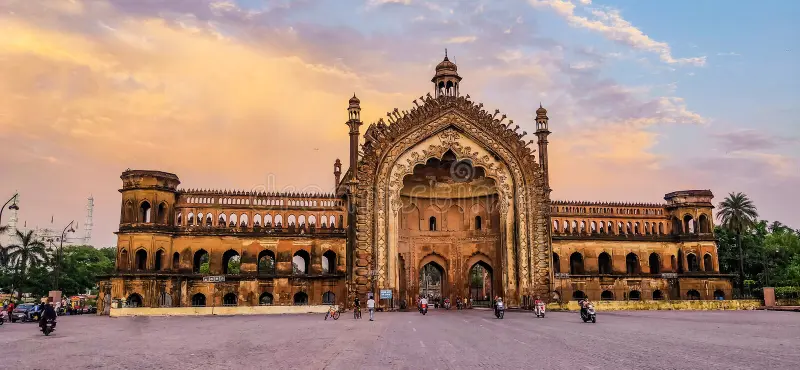Located in the heart of old Lucknow, Rumi Darwaza is an iconic symbol of Nawabi grandeur. Visitors often have questions about its history, ticket price, and the material it’s built from. If you’re fascinated by its architecture and cultural legacy, the history of Rumi Darwaza will certainly intrigue you.
This magnificent monument was built in 1784 by Nawab Asaf-ud-Daula as part of a famine relief project, providing employment to the masses. Interestingly, it is not made of a single stone but constructed using Lakhouri bricks and lime mortar — a brilliant example of 18th-century engineering. A bonus for travelers: there is no ticket required to visit Rumi Darwaza, as it still forms part of a bustling city route. Just about 1.5 kilometers away, you’ll also find the stunning Chota Imambara, making it easy to witness two of Lucknow’s finest heritage sites in one visit.
| Details | Information |
|---|---|
| Entry Fee | Free |
| Location | Hussainabad, Old Lucknow, Uttar Pradesh |
| Nearest Metro | Charbagh Metro Station (~3.5 km) |
| Nearest Hotel | Hotel Levana, Clarks Avadh, Hotel La Place |
| Opening Time | Open 24 hours (Best time: Morning & Evening) |
| Distance from Charbagh | Approx. 4 km |
| Distance from Airport | Approx. 13 km (Chaudhary Charan Singh Intl.) |
| Distance to Chota Imambara | Approx. 1.5 km |
Rumi Darwaza: A Symbol of Awadhi Grandeur
As you step into the streets of old Lucknow, a towering and intricately designed gate welcomes you — this is Rumi Darwaza, also known as the Turkish Gate. Soaring at 60 feet, it’s one of the most famous architectural attractions in Lucknow, and was once the ceremonial entrance to the city.
History and Inspiration
This architectural marvel was constructed in 1784 by Nawab Asaf-ud-Daula, the fourth Nawab of Awadh. The design was inspired by Bab-e-Humayun in Constantinople (modern-day Istanbul), reflecting the cultural and artistic connections between Awadh and the Ottoman Empire.
But Rumi Darwaza wasn’t built just as a show of architectural flair — it was part of a noble initiative during a terrible famine in the 1780s. To combat starvation and provide employment, the Nawab commissioned the construction of public works, including the Bara Imambara and Rumi Darwaza. It stands today not just as a monument, but as a symbol of compassion and leadership.
Unique Architecture and Design
The Rumi Darwaza is a masterpiece of Awadhi, Persian, and Roman architectural influences:
Three-Storey Illusion:
From the front, it appears as a grand arched gateway. But from the rear, it reveals a three-storey façade, enhancing its grandeur. While vehicles once passed directly beneath it, the route has now been diverted to preserve this priceless heritage.
Construction Material:
It is made of Lakhouri bricks — a signature of Nawabi architecture — and joined with a special mortar mix including lentils, red lead, and gum, giving it remarkable strength and longevity. Notably, no iron or wood was used in its construction.
Fine Carvings:
The arch is adorned with intricate floral and clove-shaped designs. Interestingly, when observed upside down, the motifs resemble the elegant neckline patterns of Lucknowi Chikankari kurtis, reflecting the city’s rich textile traditions.
📌 For more heritage travel inspiration, check the official tourism portal: Uttar Pradesh Tourism – Rumi Darwaza
Whether you’re an architecture enthusiast, a history buff, or simply a curious traveler, Rumi Darwaza offers a mesmerizing glimpse into the royal legacy of Lucknow. It’s not just a monument, but a reminder of how art, compassion, and culture once came together in times of adversity. Don’t forget to visit the nearby Chota Imambara, Clock Tower, and other heritage gems during your trip!

